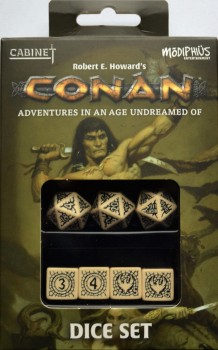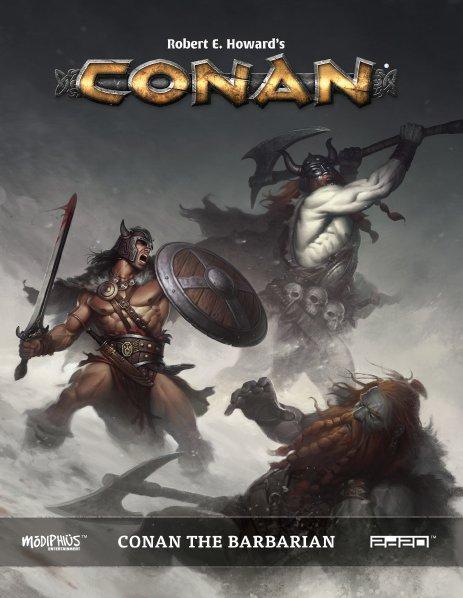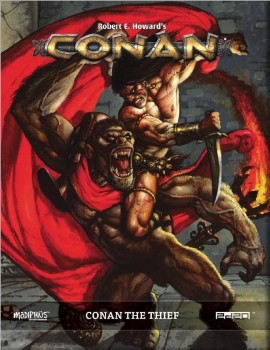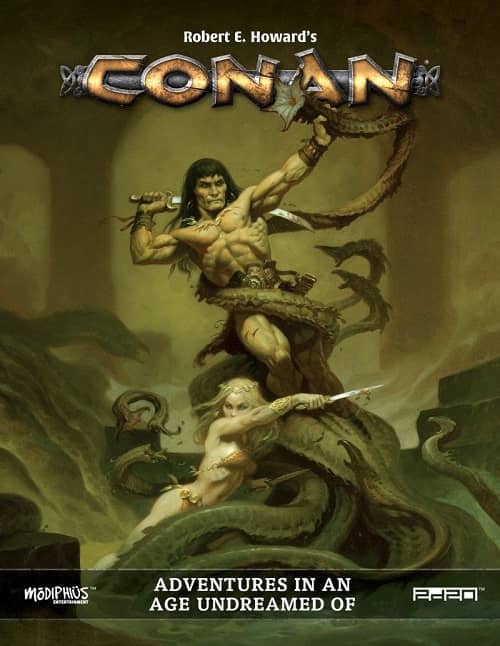A Report on Modiphius’s Robert E. Howard’s Conan: Adventures in an Age Undreamed Of — Part One
That title is probably the last time, in this article, that I’m going to refer to this game with all those words. It was important to get it right, the first time, but usually I just call it Conan 2d20.
Because that’s what it is: it is playing a Conan game by using Jay Little’s 2d20 engine or mechanic, which he designed for Modiphius. There are other Conan RPGs out there, all of them, of course, out of print: an “original” TSR Conan RPG (I’ve never had the experience), a GURPS version (I only just learned about this one, and I’ve never played GURPS — the Hero System was my game of choice during the “universal system” era), and Mongoose’s d20 version (which I did play, at GaryCon one year, and it was a delight!). Outside of RPGs designed — or modified — specifically to accommodate a Conan vibe and setting, there are a number of options ranging from d20 derivations from Astonishing Swordsmen & Sorcerers of Hyperborea to Low Fantasy Gaming to Crypts & Things to Sharp Swords & Sinister Spells to “other system” derivations such as Savage Worlds to RuneQuest to Barbarians of Lemuria to many others that I’m either forgetting or about which I simply don’t know. Of these other games, when I make an argument that Conan 2d20 is my most favorite system for accurately emulating Conan pulp fiction, I should make clear that I have not played all of them, though I have read (and even played) most of those listed above.
Getting into Conan 2d20, for the casual gamer, or for the merely curious, demands a fair amount of cognitive load. This is because, I believe, the system is so innovative — and those innovations are precisely what makes this a Conan game. I have encountered many anecdotes of gamers and consumers gleefully obtaining this gorgeous hardcover tome (or PDF), riffling through it, saying, “Huh?” then setting it aside with a “Sorry, not for me, but the art is pretty, and this still makes a good resource.” This describes my own initial reception, as I was losing my mind to higher Levels of play in Pathfinder and, with immense relief, was going “old school” by picking up Swords & Wizardry. But I kept sneaking glances at Conan 2d20 and thinking “what if?” Bob Byrne and I tried to do something via Play by Post. In my home group, a year or so later, I got a 1e enthusiast to start running for my casual players so that I could give 2d20 a go with two seasoned players. But then, after I had successfully run two adventures, the pandemic hit, and these two players weren’t interested in online play.
But by that time I was hooked. I understood the game. I clearly perceived its virtues. In fact, I didn’t want to play much else. The pandemic became something of a gaming opportunity, as I learned how to play online and encountered gamers who are just as passionate about this system and this property as I had become.
I’m going to try to communicate this enthusiasm to you, and, to do so, I have first the perhaps insurmountable task of explaining the design principles and consequent innovations inherent in this RPG.
The Core Mechanic
 It is called 2d20. What this means is that, at “base,” every player character has access to two 20-sided dice that the gamer can use to roll for his hero to succeed at various tasks. But this observation can be misleading. A number of elements in this game allow a character to roll more than 2d20, but seldom more than 5d20, which is the human maximum for task resolution.
It is called 2d20. What this means is that, at “base,” every player character has access to two 20-sided dice that the gamer can use to roll for his hero to succeed at various tasks. But this observation can be misleading. A number of elements in this game allow a character to roll more than 2d20, but seldom more than 5d20, which is the human maximum for task resolution.
How Do You Get More d20s?
First, let’s look at why you are rolling d20s in the first place. As with most games, various tasks represent various levels of challenge. Challenge, in this game, is called Difficulty. Just as characters (in most cases) never can roll more than 5d20 for a Skill Test, Difficulty never exceeds 5 (Difficulty usually is denoted D#; or, for example, Difficulty 5, for efficiency’s sake, would be rendered D5). Outside of D5, a task simply is impossible. Whenever, in the game, character failure would be interesting, the GM or the rules assigns a Difficulty to the challenge. The player rolls a number of d20s. Every d20 that winds up presenting a value lower than the character’s relevant Skill results in a Success. So, if the GM were crazy enough to say that a challenge is D5, the player would have to somehow get that by rolling as many as 5d20 and furthermore hope that all of those dice roll under the Skill for one Success each. I should add that, by explaining, I have wandered into an extreme example, for most challenges are simply D1; i.e., if there is any challenge at all — or if failure would be interesting — the character requires one Success, for, after all, success is success.
Design Considerations
I believe the roll-under mechanic described here is the first obstacle to traditional gamers — any who have normative expectations, that is — to become comfortable with these rules. What 2d20 asks of the gamer is to roll low to get a high number of Successes over a Difficulty. Actually, it’s not all that different from the code switching inherent in early forms of D&D, and I argue that, overall, 2d20’s resolution is more efficacious than the core mechanic of original D&D onward to this day. Game design philosophy explains that this is because it’s a lot less work for the human mind to compare two numbers — even a range of numbers — than it is to add modifiers in relation to a sometimes-evolving target number. My point is that, once learned, 2d20 runs faster than one’s average d20 system, and, as shall be seen, there are other benefits.
Okay, so, How Do You Get More d20s?
You get them from various resources, i.e., “pools” that often, in gaming circles, are called meta-currencies. In Conan 2d20, there are three of these “spends:” Momentum, Fortune, and Doom. Now, any readers who are familiar with the 2d20 system are going to notice, in the forthcoming explanations, that I have left out some of the more nuanced — some would say “fiddly” — applications of these currencies. I have done so because my purpose here is to reveal the core principles of this game. I’m trying not to overburden new understandings of this system; though, once an exploration is begun, actual game-play, in my opinion, reveals that these nuances are sensible and intuitive.
Momentum
 Whenever a character rolls more Successes than what is required for a certain task, these additional Successes become a form of currency called Momentum. Momentum has many uses or “spends,” but, within the topic here of obtaining more than 2d20 for a test, any Momentum not used immediately following a task can be put into a collective pool (that never can exceed 6) that all players can draw upon at will. In the application here, one Momentum can be spent for +1d20 to a test per Momentum. So, in general, as many as three Momentum can be spent, out of the collective pool, by one character at a time, to get the (usual) maximum of 5d20 on a Skill Test.
Whenever a character rolls more Successes than what is required for a certain task, these additional Successes become a form of currency called Momentum. Momentum has many uses or “spends,” but, within the topic here of obtaining more than 2d20 for a test, any Momentum not used immediately following a task can be put into a collective pool (that never can exceed 6) that all players can draw upon at will. In the application here, one Momentum can be spent for +1d20 to a test per Momentum. So, in general, as many as three Momentum can be spent, out of the collective pool, by one character at a time, to get the (usual) maximum of 5d20 on a Skill Test.
What This Represents
In this game, the 2d20 system has been adapted to emulate the “fast paced” pulp action of the Conan stories. Excelling at task resolution results in greater-than-expected benefits for the challenge at hand, or in “momentum” that is shared and enjoyed by the entire player group. In other words, when things are good, they are very good. This has its converse, though, of course, which shall be explained in the discussion regarding Doom.
Fortune
Player characters (and some non player characters) have an additional, non-shareable resource called Fortune. This represents, of course, the hero’s good luck, which sometimes runs out. As with Momentum, Fortune has a variety of uses, but, for the purposes of meeting or exceeding Difficulty, one Fortune point can be used to award one d20 “pre-rolled” as 1. This counts towards the usual maximum of 5d20. Also, in most cases, this results in two Successes.
Here’s Why
As in many RPGs, in Conan 2d20 character ability is determined by a combination of Attributes and Skills. Also, as in many games, in Conan 2d20 a single Attribute is keyed to or governs a variety of Skills. If a character is particularly skilled at all, that character has one or two values attached to that Skill. These are Focus and Expertise. To begin with Expertise, this number merely raises the associated Attribute so that the Target Number is easier to roll at or under during a Skill Test. Now, if a player likewise rolls under the Focus of that Skill, two Successes are generated.
Doom
If a player doesn’t have access to Momentum and/or Fortune to improve the chance or potential degree of task success; or if, for whatever reason, the player doesn’t want to use it or just some of it, the player may “pay Doom” to the GM for the same benefits Momentum provides. The difference is that now the GM has more Doom. This is a currency that (unlike Momentum, is not capped at 6) that the GM can use, as Momentum, to make more capable her NPCs or PC adversaries. Doom also can be used to introduce sudden elements that challenge the PCs, such as problematic terrain, weather, surprise adversarial reinforcements, traps, sorcerous effects, setbacks, etc. In other words, a player, through his PC, can gamble for all-but-assured success, knowing that this expenditure comes with a price that is enacted either now or later. Most GMs I know calmly watch their piles of Doom tokens accumulate, until they decide to suddenly spend them by hammering away on the PCs during the culmination of a well-chosen scene. It also should be noted that players, likewise, watch this pile accumulate. There is a reason, after all, why it’s called “Doom.”
What This Represents
It is remarkable how some of the mechanical components of this game system sync up with what frequently is taught in writing courses. In this game, the players and GM — who, it may be seen here, is also a “player” beyond what we typically think of when we consider the duties of a GM — are handed tools that simulate a protagonist trying to get what she wants or going after a goal (a writing lesson), in some cases making it increasingly difficult to get those things because of complications resulting from that very attempt (again a writing lesson). In relation to this, another game feature should be noted here, that Complications occur every time a player rolls a 20 (and sometimes 19) on a Skill Test. This results in either an immediate, minor problem for the PC to overcome or in 2 Doom for the GM to set aside for later use.
 If you haven’t played this game, and if you now are trying to imagine how this dynamic works at the game table, you might be foreseeing a fairly “swingy” pendulum of tension and release, or of peril and victory, and you won’t be entirely wrong. If, however, you think that this also will translate into tedium or predictability, you’re only partially right. And I maintain that this occurs only when people play this game wrong.
If you haven’t played this game, and if you now are trying to imagine how this dynamic works at the game table, you might be foreseeing a fairly “swingy” pendulum of tension and release, or of peril and victory, and you won’t be entirely wrong. If, however, you think that this also will translate into tedium or predictability, you’re only partially right. And I maintain that this occurs only when people play this game wrong.
Gasp! What? Anathema! In rpg discourse, there is no such thing as “playing it wrong.” Usually, I agree with this dictum, but, respectfully and humbly, if you want to get the most enjoyment out of Conan 2d20 — or if you simply want to flatten the curve of your own learning process — please consider the following:
Play for keeps. Bet it all. You want to succeed at something and there’s Momentum on the table? Use it! Use it all! Got Fortune? Burn it! Are you out of both? Throw Doom at the GM. Who cares how much she has. Would Conan care? Does Conan do things in half measures? By Crom, we all die anyway, and we’re alive now! Fortune favors the brave! Only through great risk comes the crown of Aquilonia.
And here’s the mechanical component of this advice that I have seen overlooked: Momentum, like Doom, is aptly named; to keep up one’s momentum one must spend Momentum. The more dice you roll, the more Successes you are likely to generate, which are likely to translate into yet more Momentum. Conversely, you’re also more likely to generate Complications (on a roll of 20 and sometimes also 19). But who cares? Would Conan care? He can deal with it.
And so can your own characters. In Conan 2d20, PCs begin powerful, especially if the standard method of character generation is used (there is an alternative generation system called Shadows of the Past that results in characters who aren’t quite so formidable, and this is particularly useful when a long campaign is intended). I believe it is to play in the incorrect spirit, if players are unduly cautious, or if too great attention is paid to resource management.
It’s probably no surprise to any readers here that I interact with many rpg communities and that I have a great interest in rpg design, philosophy, and practice. Many will say — and it might be you — that a GM does not need a resource such as Doom with which to challenge players, that a player does not need Momentum or Fortune or even Doom with which to overcome obstacles, but only quick wits, a creative mind, and the mostly-static numbers on the character sheet and in the monster and room descriptions. And you are not wrong. But, in my enthusiasm for Conan 2d20, I maintain that d20 systems ask of the GM quite a bit more art and innovation to get at the “story-centered” aspect of pulpy Weird fiction emulation that 2d20’s tools readily provide.
They are, indeed, tools. In a traditional d20 game, a GM might arbitrarily inflict sudden damage on a PC, no Saving Throw permitted, arguing that it’s in essential service to the story, and the player might call foul, maintaining that’s not in any rule (except for Rule 0, which is that the GM is always right, though this type of GM is unlikely to keep players for very long). In 2d20 the GM makes it happen with Doom. In a d20 system, a wall might suddenly collapse, or a torch might go out, or a hunted NPC might slip through a secret door and secure it behind her, and the player might regard it as an abuse of the GM’s power, might feel his trust betrayed, might feel a lack of player agency, might determine that the adventure is on a railroad.
In that d20 game, in which there is not enough of a shared vision regarding gameplay, the GM is trying to tell a satisfying story, but the player thinks that’s in detrimental service to the game.
In 2d20, the GM spends Doom.
[See Part 2 of the series here.]

I backed Modiphius’ John Carter of Mars Kickstarter (which uses the same 2d20 mechanic, more or less), and one of my rewards was a full set of Conan PDFs, which I unlocked in my DriveThruRPG account and promptly forgot about.
I’ve recently fallen down yet another YouTube hole, this time watching video reviews and actual play sessions of games I’ll never, ever play, and the Modiphius Conan game has really caught my attention, so I was going through the PDFs the other day and much to my amazement, one of the files Modiphius included was the ENTIRE Mongoose Conan line, also in PDF form.
Sadly, as far as i can tell, none of those Mongoose PDFs are actually a set of the full TSR Conan line or anything like that. It’s barbarians all the way down!
I have a Conan the Mercenary and the Book of Skelos but my sandals have tread the Hyborian kingdoms too often and for too long. Its just not as exciting for me anymore. It is too familiar.
I
prefer the world of Xoth for my sword and sorcery campaigns. I think it was reviewed here couple of years back. It’s low budget compared to Modiphius and new material is sporadic though 2 new modules were just released. It’s appeal to me is that it is more of a blank slate than the Hyborian age. Also it is less euro-centric than Conan with more of an Ancient Middle-Eastern flair.
dmont – I wrote about Xoth, which is a neat world.
But the mechanics of the Conan RPG make it worth checking out. It was a very different experience from 3rd Edition and Pathfinder, which I’d mostly played the past few decades.
And Modiphius did the Conan setting really well.
Joe – Wasn’ts that cool that Modiphius included all the Mongoose titles? I used them as background materials for a game I briefly ran.
Yeah, it was very generous of them, and if I ever find myself actually running a campaign I’ll be stealing shamelessly from all possible sources.
Lack of shelf space has kept me from buying Conan or John Carter products from Modiphius but articles like this one are starting to make me rethink that. It looks like they’ve done a really nice job.
Joe H.: “I’ll be stealing shamelessly from all possible sources.”
The mark of a True G.M., good sir.
Thought about this RPG some more. Gabe and I tried to get a mini-Black Gate game going, but it didn’t quite work out. I haven’t been in the RPG world since then.
Now I’m pondering giving it a try again (I will go to any extreme to avoid actually writing stories…).
A couple thoughts: Gabe said learning this game ‘demands a fair amount of cognitive load.’
Which is to say, it
Involves a substantial learning curve; and
It’s not intuitive for a d20 player. Certainly not a D&D/Pathfinder D&D player. Which is the majority of us.
Having said that, once you put in a little effort to master the rules (I like reading DM Guides, so that was okay with me), it comes together. And it’s less constrictive than the standard d20 approach.
I’ve written posts here at BG about why I like Swords & Wizardry, and 1st Edition Pathfinder. So I’m not a d20 basher.
This game is more open for storytelling, and player action. And frankly, the Hyborian environment is wonderfully done. Add in those Mongoose PDFs from the Kickstarter as source material, and you’ve got the opportunity for an authentic Conan roleplaying experience.
And THAT is something attractive.
Give the Core Rulebook a read. You could just do the Player’s Guide, but I think you’ll benefit a lot from at least one time through the Core.
Rolling low on a d20 was not intuitive, but I got used to it. Sort of…
Byrne writes,
“I’ve written posts here at BG about why I like Swords & Wizardry, and 1st Edition Pathfinder. So I’m not a d20 basher.“
For the record, my personal go-to system is Swords & Wizardry. It’s the game I play most often. But it’s decidedly NOT the system I want to evoke a Conan milieu. I’ll address this more directly in Part Two.
[…] (Black Gate): Getting into Conan 2d20, for the casual gamer, or for the merely curious, demands a fair amount […]